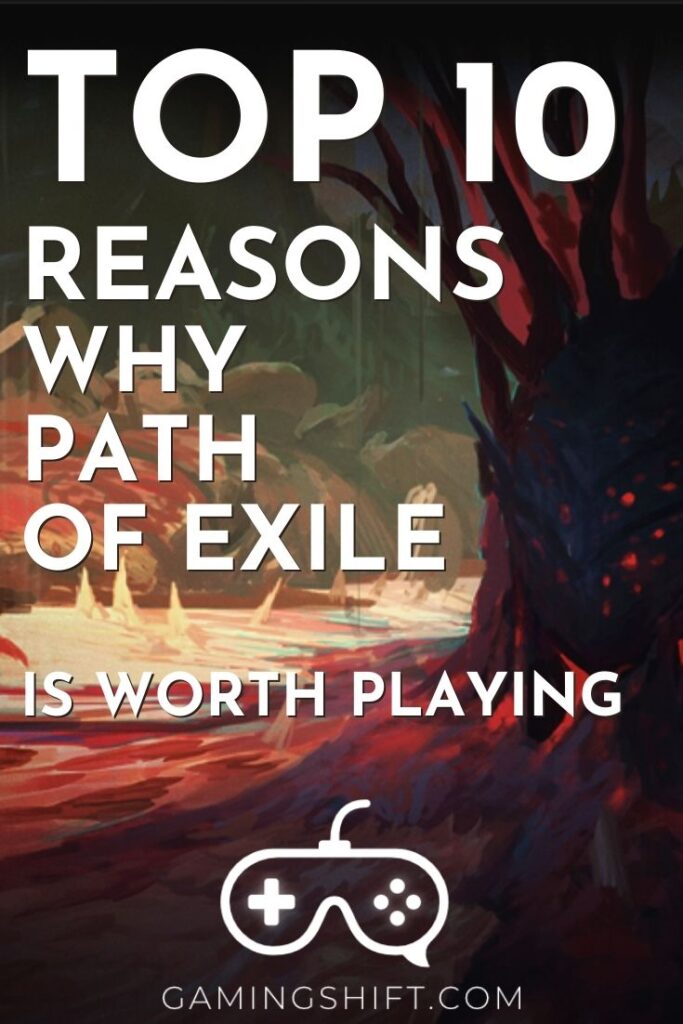Path of Exile is a free online-only action RPG developed and published by Grinding Gear Games. The initial release was for PC in 2013, with Xbox One and PS4 versions following in 2017 and 2019, respectively. Recently, there has been a lot of buzz surrounding the release of PoE 2 so many new players have shown interest in Path of Exile.
Often Path of Exile is compared to Diablo 3 and many hardcore RPG fans believe it is a better game. Diablo 3 wins in terms of visuals and campaign quality, but it removed a lot of the depth compared to its predecessor, Diablo 2. Path of Exile’s passive skill tree and class flexibility means it feels way more flexible and customizable from a player perspective. And Path of Exile’s end game plus loot is superior compared to Diablo 3.
It’s still getting content patches, new loot in the form of updates, quality of life improvements, etc. and Grinding Gears frequently communicate with their player base. This alone is enough for me to recommend Path of Exile, as the game gets new leagues (quarterly content updates) every 3 months.
It’s 100% Free! Who Doesn’t Like Free Stuff?
The thing with free to play games is that there’s really no harm in trying them out, as long as you have a couple of hours of time to spare. Plus, this isn’t some shady mobile game loaded with greedy microtransactions. Path of Exile is a top-tier RPG comparable with the likes of Diablo and World of Warcraft (even better than the aforementioned legends in some respects).
Plus, Path of Exile gets free quarterly content updates and expansions all the time. You can grind your way through the entire game without paying a single penny, and while there are microtransactions, they aren’t too intrusive. The paid content involves armor sets, rare spells with enhanced powers, stash stubs, etc.
I believe the Path of Exile’s free-to-play nature is one of the biggest strengths it has, compared to rivals such as World of Warcraft or Diablo III. And you don’t have to pay recurring monthly/ subscription fees, nor is there a need to purchase expansions since those are free too. There are no UI customizations that must be unlocked by paying money, nor is there a paywall in front of certain races or classes.
Quarterly Content Updates (Leagues)
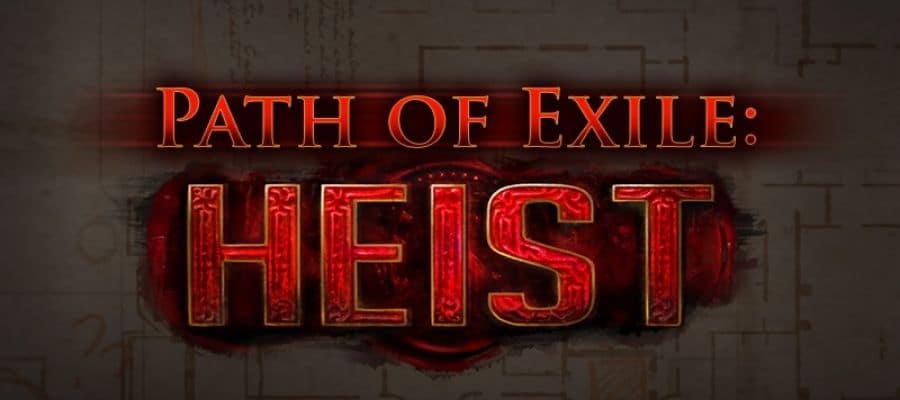
Often, online action-RPG games tend to fall off tremendously over the course of just a couple of years because the developers don’t release new content updates. No new loot, new mechanics, classes, weapons, armor, etc. Such is not the case with Path of Exile since it gets constant free updates on a quarterly basis in the form of Leagues.
Every League brings with it exciting new changes like previously unseen bosses, drops, new mechanics, new items and methods for crafting, etc. These Leagues are timely exclusives so you must get in at the time of release to make the most out of them. Because certain mechanics and items will be discarded at the end of the League.
Every League has a unique theme and lore behind it, so the game feels fresh once more. Even if you’ve unlocked every single class and weapon, every piece of armor, or crafted everything that can be crafted, Leagues bring new content for you to spend time on. This in combination with the Path of Exile’s passive skill tree and gem system gives the game immense replayability.
Endless Customization Of Roles And Playstyles
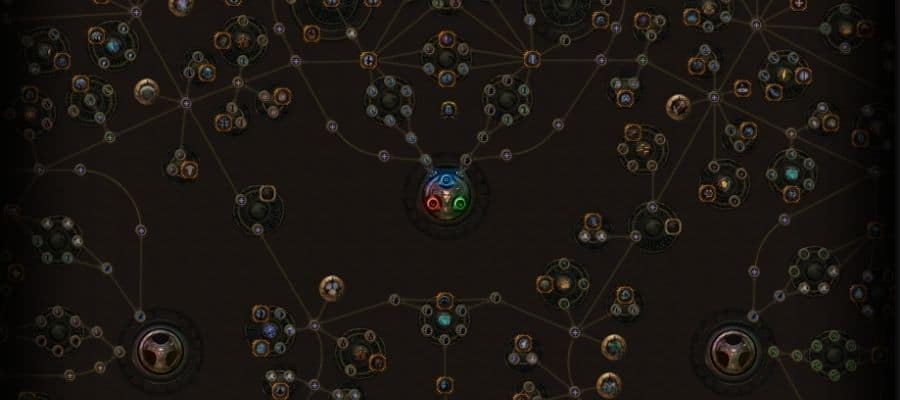
In most RPGs you pick your class, this class has a specific role and certain strengths/ weaknesses. Then you can upgrade whatever stats you want within that class, which is about the full extent of character customization you get. But in Path of Exile, skills, and abilities are tied to skill gems that fit into your gear.
Everything from your helmet to your shoe can be used to obtain new abilities by socketing skill gems, and there are hundreds of these gems to choose from. There are two types of skill gems- Active and Support. Active skill gems grant an active skill and can be further enhanced or augmented with support skill gems.
Support skill gems often modify an existing active skill to change how it works, increasing its power at the cost of extra mana requirement. Certain active and support gem combinations will leave the skill unmodified. In addition to skill gems Path of Exile also has a passive skill tree that adds stats and attributes to your character as you level up.
Note: Every class in Path of Exile uses the exact same passive skill tree, but starts in different places. Whenever you complete in-game activities and level up, you gain a character point that you can allocate to a node on this skill tree. A node must be connected to an active node in order for you to access it, i.e. you can’t just randomly walk your way through the skill tree without connecting nodes. This is called designing your character’s “passive path”.
A Gigantic Content Backlog To Play Through
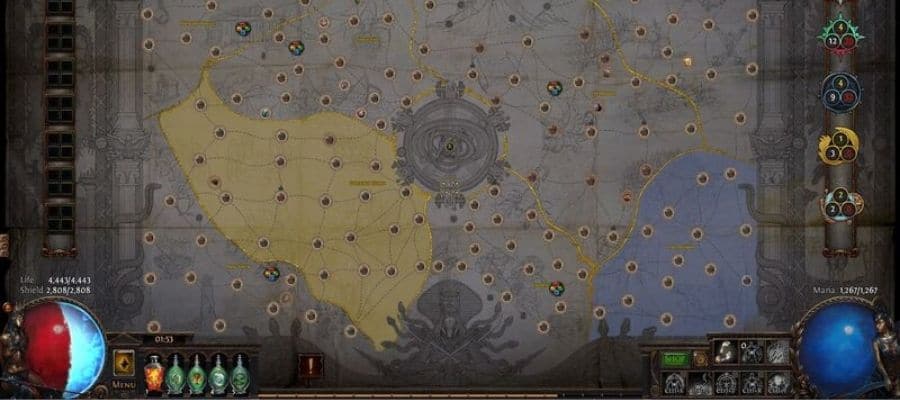
New players coming into the Path of Exile are often spoiled by too many choices in terms of content. First, you have “Maps”- these are the primary kind of endgame content in Path of Exile. These are used by placing them inside a map device which then consumes the map to generate a randomized instance containing lots of monsters and a boss fight.
Maps come in various rarities (normal, magic, rare, unique) and have unique qualities that can be improved with a Cartographer’s Chisel. You get to use maps only after completing the 10th Act, when you do the Epilogue quest “Picking Up The Pieces” that adds a map device to your hideout. At the time of writing this article, Path of Exile has 147 base maps plus 29 unique maps.
After maps, there is “Delve” which refers to the exploration of an infinite Azurite Mine Dungeon. Once you encounter Niko, Master of the Depths in Act 4, you can start delving. You guide a crawler (minecart) which is powered by Sulphite, discovering new checkpoints and routes through the mine. Exploration grants you hidden loot and access to previously locked paths/ checkpoints.
Finally, you’ve got the “Labyrinth” which is a randomly generated dungeon crawler containing all sorts of things from traps and puzzles to monsters and loot. The final boss is Izaro, upon defeating him and completing the Labyrinth you unlock the Ascendancy subclass for your character as well as the Ascendancy skill tree. You get unique equipment and enchantments, plus a spot on the competitive leaderboards containing players from all over the League.
Immersive And Detailed Environment

Path of Exile is one of the most interesting ARPGs for one reason- its excellent and highly diverse world. There are tons of enemy types as well as many different ways for you to die, so you’re constantly presented with new challenges and need to keep learning. The visuals aren’t exactly modern since this game is pretty old, but they have this dark and brooding undertone which adds to immersion.
Small things like the lighting and environmental effects within a tileset add to the feeling that you’re playing a serious ARPG, not a watered down RPG like Diablo 3. Another cool little thing about Path of Exile is how its dungeons and levels are procedurally generated so no two playthroughs are the exact same. This is one of the things the developers are Grinding Gears did to ensure infinite replayability and an evergreen experience.
Dark gothic themes and challenging enemies aside, Path of Exile really helps you simulate that “rags to riches” fantasy in whatever way you please. You start from nothing and become all-powerful, achieving your dreams while encountering cool NPCs and plenty of interesting lore along the way.
Fun Fact: Did you know you could make REAL money with Path of Exile items? Yep, certain in-game items can be traded on sites like eldorado for actual money. This procedure is called item flipping (make sure you check the site for reliability and read user reviews before going in).
The Sheer Complexity And Layered Mechanics
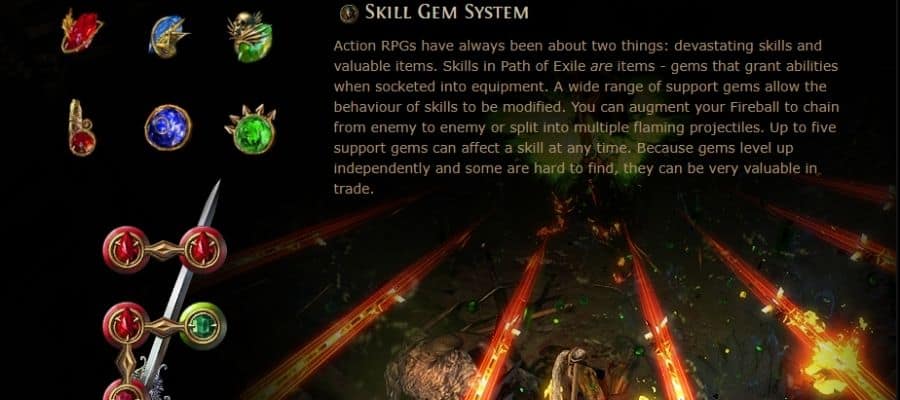
Path of Exile is mechanically deep, layered with intricate details for the player to explore while customizing their character almost free from any restrictions whatsoever. Classes and roles are but a path you can take to achieve your end goal, there is no strict rules surrounding what spells, attributes, weapons, etc. a specific class can wield.
Combine this with the constant innovation of content in the form of seasonal expansions, as well as the in-game economy which is totally different from literally any other RPG. Then there are the various systems such as Temple, Delve, Labyrinth, etc., there is no doubt that PoE is one of the most complex action RPGs in existence. And both the developers as well as players take pride in this fact.
It differentiates the PoE crowd from casuals and players who simply want the flavor of the season game based on what journalists tell them is good. The web style skill tree with hundreds of nodes and interconnected abilities looks like the map of a galactic system in terms of complexity and size. You can traverse and unlock any node along with its respective buffs/ spells.
Massive Variety Of In-Game Content
It is an RPG, but a multiplayer online game first. So, what game modes do you have access to within the Path of Exile? When you boot up the game, you’ll be presented with some options like Heist, Standard, and Hardcore. Heist is the current season or League at the time of writing this article, and it has its own unique challenges/ bosses/ loot which is available on a timely basis every 3 months.
Temporary leagues such as Heist, Harvest, Delirium, etc. are timed exclusives and released on a quarterly basis. They have their own fun minigames, mechanics, exclusive rules, etc. A character you create in this temporary league will be moved into the standard league later down the line. Standard is simply the basic league without any modifiers.
While a lot of mechanics and items are discarded after each temporary/ seasonal league ends, some of it makes it into Standard. Hardcore has the “hardcore modifier”- if any characters die here, they move to Standard (sort of like permadeath in other RPGs). Characters and items in hardcore aren’t automatically deleted.
Finally, there are Private leagues which you can purchase with actual money. These are like custom servers in which you can add your own modifiers to make the game more interesting/ challenging. For example- disabling vendors/ stash, no flash refill at towns, increased monster stats, etc.
Excellent Game Economy
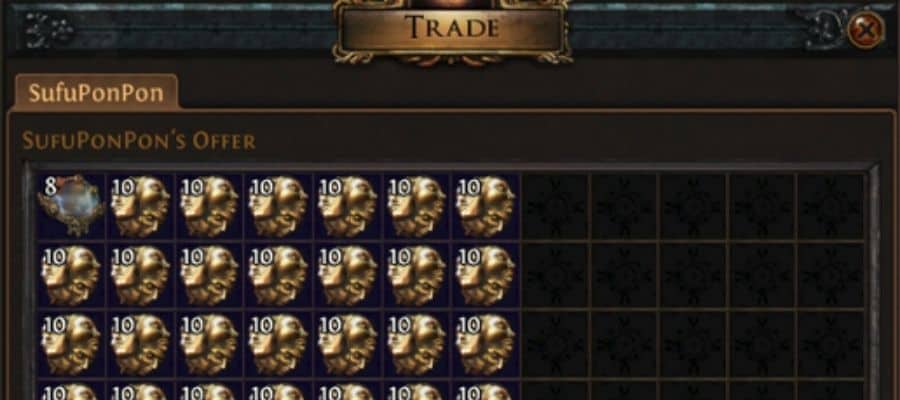
In a traditional RPG, what do you do when you wish to purchase stuff? You spend gold, that you earn from quests and challenges. But in Path of Exile, there is no gold or similar in-game currency. Instead, this game uses a barter system like the good old days back in 6000 BC when we would trade items for other items.
And that is exactly what PoE makes you do- trade things you don’t need/ perceive to have a lower value, for things that you deem to have a higher value. The problem with normal gold-based economies is inflation. Since any monster or stash can net you gold and the total amount of gold in the game world keeps increasing.
Hence, the value of each individual gold coin keeps decreasing. Gold itself has no intrinsic value; its value is simply decided by the other resources/ items that players purchase with it. Other RPGs and developers will often build “money sinks” into their games to naturally remove some of the excess gold influx. Once gold loses its value, players turn to other in-game currency for P2P trading.
PoE has many items that are known as “currency items”, ideal for bartering with. Currency items provide value by helping in the crafting and enhancement of equipment, or by allowing restructuring of passive skill trees. Popular and sought after currency items change from season to season, some of them include Chaos Orbs, Gemcutter’s prisms, etc.
The Community Is Still Active And Thriving
The Path of Exile community is a very dedicated, hardcore, and serious yet friendly group of players who have stuck with this game through thick and thin. There are tons of community-made guides in the form of articles, blog posts, Youtube videos, and more. Plus, you have the excellent community made Path of Building tool which is available on GitHub that you can use to plan your character build in an easy, efficient manner.
Shop indexer sites like poe.trade make it very easy to keep a tab on item rates and allow you to get upgrades for cheap. Then, there is of course the official Path of Exile site where you can access the latest news regarding patches, updates, content releases, etc. If you want to keep a tab on exchange rates in PoE, check out poe.ninja which constantly uses the Public Stash Tab API to track all relevant items put up for sale.
Now that the developers are communicating more frequently regarding seasonal updates players are more energized than ever before. The player count on PC at least can be gauged from steamcharts, where around 100 to 120k peak players can be seen at the start of a new season. This doesn’t include console numbers, and PoE is available on both Xbox One as well as PS4.
Challenging Gameplay Which Feels Very Rewarding
The classless design and skill gems already add several layers of complexity to the game, not to mention the different damage types and attributes you have to keep in mind. No zones are restricted, and classes aren’t behind paywalls which gives you an endless amount of options in terms of what you can do. But all these choices mean it’s upon the player to decide what is in their best interest before completing even a fraction of the game or fully understanding its intricacies.
Then there’s the Hardcore league which has a rule somewhat similar to permadeath, except your character isn’t automatically deleted if you die. Want to crank up the difficulty even further? There’s this system called Solo Self-Found (SSF) which makes it so your character cannot interact with other human players. Meaning, you can’t party with people or trade. Every item you earn is yours to keep and nobody can help you.
Thankfully, there are tons of build guides on Youtube for you to follow if you’re a new Path of Exile player. The Path of Building tool helps you try various strategies before committing to any single path with your skill points. The gameplay can feel a bit clunky when a new seasonal expansion lands and creases haven’t been ironed out yet, but the overall experience is nothing short of amazing.
Conclusion
In summary, the Path of Exile is an excellent action RPG that strays away from the well-defined norms within this genre and dares to experiment with the economy and builds. The result is an experience unlike anything else, and despite its age, the game is getting constant seasonal content updates with new loot and bosses. As a player, you’ll never get bored and there’s tons of community-generated content online in the form of articles/ build guides/ tips, etc. for you to follow. Tip: If you’re a newcomer to Path of Exile, I highly recommend you check out Engineering Eternity and ZiggyD Gaming on Youtube.
If you found this article useful, you may want to save this pin below to your Gaming board.
